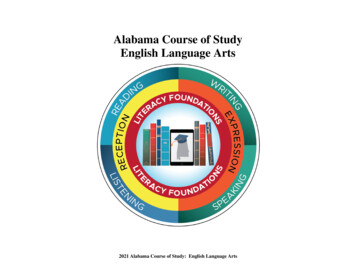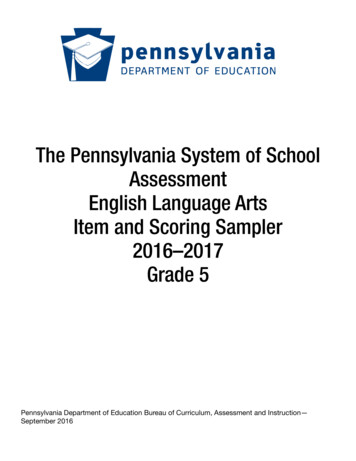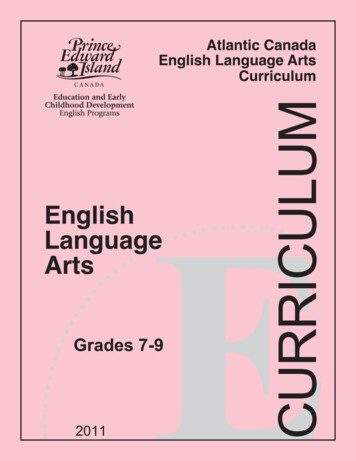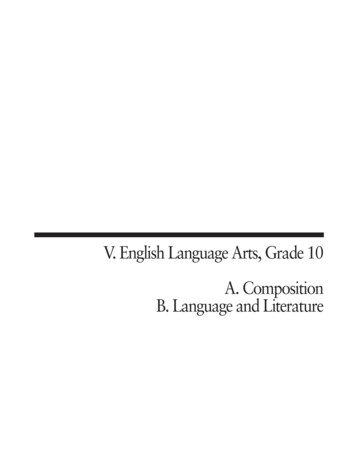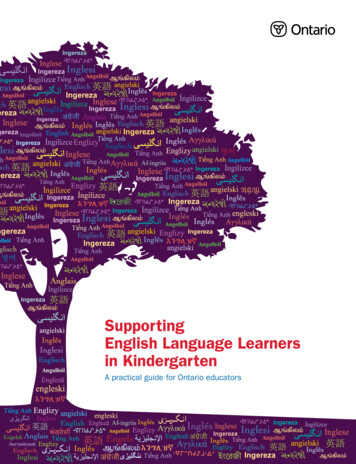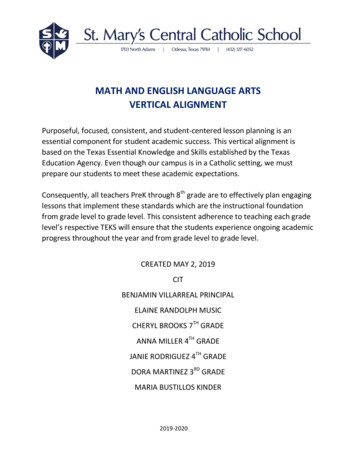
Transcription
MATH AND ENGLISH LANGUAGE ARTSVERTICAL ALIGNMENTPurposeful, focused, consistent, and student-centered lesson planning is anessential component for student academic success. This vertical alignment isbased on the Texas Essential Knowledge and Skills established by the TexasEducation Agency. Even though our campus is in a Catholic setting, we mustprepare our students to meet these academic expectations.Consequently, all teachers PreK through 8th grade are to effectively plan engaginglessons that implement these standards which are the instructional foundationfrom grade level to grade level. This consistent adherence to teaching each gradelevel’s respective TEKS will ensure that the students experience ongoing academicprogress throughout the year and from grade level to grade level.CREATED MAY 2, 2019CITBENJAMIN VILLARREAL PRINCIPALELAINE RANDOLPH MUSICCHERYL BROOKS 7TH GRADEANNA MILLER 4TH GRADEJANIE RODRIGUEZ 4TH GRADEDORA MARTINEZ 3RD GRADEMARIA BUSTILLOS KINDER2019-2020
Prekinder MathPK.V.A Counting SkillsPK.V.A.1 Child knows that objects, or parts of an object, can be counted.PK.V.A.2 Child uses words to rote count from 1 to 30. Names of numbers - up to 10 (K-C.23)Count forward - up to 20 (K-D.11)Names of numbers - up to 20 (K-D.13)PK.V.A.3 Child counts 1-10 items, with one count per item. Learn to count - up to 3 (P-A.1)Count objects - up to 3 (P-A.2)Count dots - up to 3 (P-A.3)Count shapes - up to 3 (P-A.4)Learn to count - up to 5 (P-B.1)Count objects - up to 5 (P-B.2)Count dots - up to 5 (P-B.3)Count shapes - up to 5 (P-B.4)Learn to count - up to 10 (P-C.1)Count objects - up to 10 (P-C.2)Count dots - up to 10 (P-C.3)Count shapes - up to 10 (P-C.4)PK.V.A.4 Child demonstrates that the order of the counting sequence is always the same,regardless of what is counted. Count objects - up to 3 (P-A.2)Count shapes - up to 3 (P-A.4)Count objects - up to 5 (P-B.2)Count shapes - up to 5 (P-B.4)Count objects - up to 10 (P-C.2)Count shapes - up to 10 (P-C.4)PK.V.A.5 Child counts up to 10 items, and demonstrates that the last count indicates how manyitems were counted.2019-2020
Learn to count - up to 3 (P-A.1)Learn to count - up to 5 (P-B.1)Learn to count - up to 10 (P-C.1)PK.V.A.6 Child demonstrates understanding that when counting, the items can be chosen in anyorder.PK.V.A.7 Child uses the verbal ordinal terms. Ordinal numbers (1-A.21)PK.V.A.8 Child verbally identifies, without counting, the number of objects from 1 to 5. Represent numbers - up to 3 (P-A.8)Represent numbers - up to 5 (P-B.8)PK.V.A.9 Child recognizes one-digit numerals, 0-9. Represent numbers - up to 3 (P-A.8)Represent numbers - up to 5 (P-B.8)Represent numbers - up to 10 (P-C.8)Names of numbers - up to 10 (K-C.23)PK.V.B Adding To/Taking Away SkillsPK.V.B.1 Child uses concrete models or makes a verbal word problem for adding up to 5objects. Add with pictures - sums up to 5 (K-I.1)Addition sentences - sums up to 5 (K-I.2)PK.V.B.2 Child uses concrete models or makes a verbal word problem for subtracting 1-5objects from a set. Subtract with pictures - numbers up to 5 (K-K.1)Subtraction sentences - numbers up to 5 (K-K.2)PK.V.B.3 Child uses informal strategies to share or divide up to 10 items equally.PK.V.C Geometry and Spatial Sense SkillsPK.V.C.1 Child names common shapes.2019-2020
Circles (P-K.2)Squares (P-K.3)Triangles (P-K.4)Rectangles (P-K.5)Circles, squares, and triangles (P-K.6)PK.V.C.2 Child creates shapes.PK.V.C.3 Child demonstrates use of location words (such as "over", "under", "above", "on","beside", "next to", "between", "in front of", "near", "far", etc.). Inside and outside (P-F.1)Left and right (P-F.2)Left, middle, and right (P-F.3)Top and bottom (P-F.4)Top, middle, and bottom (P-F.5)Above and below (P-F.6)Beside and next to (P-F.7)PK.V.C.4 Child slides, flips, and turns shapes to demonstrate that the shapes remain the same. Flip, turn, and slide (1-V.6)PK.V.D Measurement SkillsPK.V.D.1 Child recognizes and compares heights or lengths of people or objects. Long and short (P-I.1)Tall and short (P-I.2)PK.V.D.2 Child recognizes how much can be placed within an object. Holds more or less (P-I.4)PK.V.D.3 Child informally recognizes and compares weights of objects or people.Light and heavy (P-I.3)PK.V.D.4 Child uses language to describe concepts associated with the passing of time. A.M. or P.M. (K-O.5)Seasons (K-O.7)PK.V.E Classification and Patterns SkillsPK.V.E.1 Child sorts objects that are the same and different into groups and uses language todescribe how the groups are similar and different.2019-2020
Different (P-G.1)Same (P-G.2)Same and different (P-G.3)Classify shapes by color (P-G.4)Classify and sort by color (P-G.5)Classify and sort by shape (P-G.6)PK.V.E.2 Child collects data and organizes it in a graphic representation. Making graphs (K-Q.1)PK.V.E.3 Child recognizes and creates patterns. Color patterns (P-H.1)Size patterns (P-H.2)Shape patterns (P-H.3)2019-2020
Kinder MathThe student uses mathematical processes to acquire and demonstrate mathematicalunderstanding.A . apply mathematics to problems arising in everyday life, society, and the workplace; Addition word problems - sums up to 5 (K-I.6)Addition word problems - sums up to 10 (K-J.8)Subtraction word problems - numbers up to 5 (K-K.5)Coin names - penny through quarter (K-T.1)Shapes of everyday objects I (K-W.9)Shapes of everyday objects II (K-W.10)B. use a problem-solving model that incorporates analyzing given information, formulating aplan or strategy, determining a solution, justifying the solution, and evaluating the problemsolving process and the reasonableness of the solution; Complete the addition sentence - sums up to 5 (K-I.5)Addition word problems - sums up to 5 (K-I.6)Add with pictures - sums up to 10 (K-J.1)Make a number using addition - sums up to 10 (K-J.4)Complete the addition sentence - make ten (K-J.5)Complete the addition sentence - sums up to 10 (K-J.6)Addition word problems - sums up to 10 (K-J.8)Subtract with pictures - numbers up to 5 (K-K.1)Complete the subtraction sentence - numbers up to 5 (K-K.4)Subtraction word problems - numbers up to 5 (K-K.5)Subtract with pictures - numbers up to 10 (K-L.1)Make a number using subtraction - numbers up to 10 (K-L.4)Complete the subtraction sentence - numbers up to 10 (K-L.5)Subtraction word problems - numbers up to 10 (K-L.7)Different (K-P.1)Same (K-P.2)Same and different (K-P.3)C. select tools, including real objects, manipulatives, paper and pencil, and technology asappropriate, and techniques, including mental math, estimation, and number sense as appropriate,to solve problems; Count to fill a ten frame (K-C.17)Add with pictures - sums up to 5 (K-I.1)2019-2020
Add with pictures - sums up to 10 (K-J.1)Subtract with pictures - numbers up to 5 (K-K.1)Subtract with pictures - numbers up to 10 (K-L.1)Long and short (K-S.1)Tall and short (K-S.2)Light and heavy (K-S.3)Holds more or less (K-S.4)Compare size, weight, and capacity (K-S.5)Introduction to symmetry (K-V.8)Identify pictures with symmetry (K-V.9)Midpoint formula - find the endpoint (G-B.8)D. communicate mathematical ideas, reasoning, and their implications using multiplerepresentations, including symbols, diagrams, graphs, and language as appropriate; Add with pictures - sums up to 5 (K-I.1)Addition sentences - sums up to 5 (K-I.2)Add with pictures - sums up to 10 (K-J.1)Addition sentences - sums up to 10 (K-J.2)Subtract with pictures - numbers up to 5 (K-K.1)Subtraction sentences - numbers up to 5 (K-K.2)Subtraction sentences - numbers up to 10 (K-L.2)Sort shapes into a Venn diagram (K-P.9)Making graphs (K-Q.1)Name the two-dimensional shape (K-V.1)Select two-dimensional shapes (K-V.5)Two-dimensional and three-dimensional shapes (K-W.1)Select three-dimensional shapes (K-W.7)Identify shapes traced from solids (K-W.8)E. create and use representations to organize, record, and communicate mathematical ideas; Count on ten frames - up to 3 (K-A.4)Show numbers on ten frames - up to 3 (K-A.5)Represent numbers - up to 3 (K-A.6)Show numbers on ten frames - up to 5 (K-B.5)Represent numbers - up to 5 (K-B.6)Count blocks - up to 10 (K-C.4)Count on ten frames - up to 10 (K-C.6)Show numbers on ten frames - up to 10 (K-C.7)2019-2020
Represent numbers - up to 10 (K-C.8)Count on ten frames - up to 20 (K-D.3)Show numbers on ten frames - up to 20 (K-D.4)Represent numbers - up to 20 (K-D.5)Count blocks - up to 20 (K-D.15)Count blocks - up to 30 (K-E.6)Count blocks - up to 100 (K-E.9)Subtraction word problems - numbers up to 5 (K-K.5)Making graphs (K-Q.1)Interpreting graphs (K-Q.2)F. analyze mathematical relationships to connect and communicate mathematical ideas; and One more - up to 5 (K-B.7)Count one more - up to 5 (K-B.8)One less - up to 5 (K-B.9)Count one less - up to 5 (K-B.10)Count up - with numbers (K-C.15)Count up and down - with numbers (K-C.16)Before, after, and between - up to 10 (K-C.20)Count forward - up to 10 (K-C.21)Count forward and backward - up to 10 (K-C.22)Count up - up to 20 (K-D.6)Count up and down - up to 20 (K-D.7)Before, after, and between - up to 20 (K-D.10)Count forward - up to 20 (K-D.11)Count forward and backward - up to 20 (K-D.12)Fewer and more - compare by matching (K-G.2)Fewer and more - compare by counting (K-G.3)Fewer and more - compare in a mixed group (K-G.4)Fewer, more, and same (K-G.5)Compare two numbers - up to 10 (K-G.6)Identify shapes traced from solids (K-W.8)G. display, explain, and justify mathematical ideas and arguments using precise mathematicallanguage in written or oral communication. Fewer and more - compare by matching (K-G.2)Fewer and more - compare by counting (K-G.3)Fewer and more - compare in a mixed group (K-G.4)2019-2020
Fewer, more, and same (K-G.5)Write addition sentences (K-J.7)Write subtraction sentences (K-L.6)Name the two-dimensional shape (K-V.1)Squares and rectangles (K-V.3)Select two-dimensional shapes (K-V.5)Introduction to symmetry (K-V.8)Identify pictures with symmetry (K-V.9)Name the three-dimensional shape (K-W.2)Select three-dimensional shapes (K-W.7)The student applies mathematical process standards to understand how to represent and comparewhole numbers, the relative position and magnitude of whole numbers, and relationships withinthe numeration system.A. count forward and backward to at least 20 with and without objects; Count to 20 (K-D.1)Count dots - 0 to 20 (K-D.2)Count on ten frames - up to 20 (K-D.3)Count up - up to 20 (K-D.6)Count up and down - up to 20 (K-D.7)Count forward - up to 20 (K-D.11)Count forward and backward - up to 20 (K-D.12)Count blocks - up to 20 (K-D.15)Count on ten frames - up to 30 (K-E.1)Count groups of ten (K-E.2)Count to 100 (K-E.3)Count blocks - up to 30 (K-E.6)Count blocks - up to 100 (K-E.9)B. read, write, and represent whole numbers from 0 to at least 20 with and without objects orpictures; Count to 20 (K-D.1)Count dots - 0 to 20 (K-D.2)Show numbers on ten frames - up to 20 (K-D.4)Represent numbers - up to 20 (K-D.5)Names of numbers - up to 20 (K-D.13)2019-2020
C. count a set of objects up to at least 20 and demonstrate that the last number said tells thenumber of objects in the set regardless of their arrangement or order; Count to 20 (K-D.1)Count on ten frames - up to 20 (K-D.3)Tally marks - up to 20 (K-D.8)Count blocks - up to 20 (K-D.15)Count blocks - up to 30 (K-E.6)Count blocks - up to 100 (K-E.9)Count money - pennies only (K-T.3)D. recognize instantly the quantity of a small group of objects in organized and randomarrangements; Count to 3 (K-A.2)Count using stickers - up to 3 (K-A.3)Count on ten frames - up to 3 (K-A.4)Represent numbers - up to 3 (K-A.6)Count to 5 (K-B.2)Count on ten frames - up to 5 (K-B.4)Represent numbers - up to 5 (K-B.6)Count to 10 (K-C.2)Count dots - up to 10 (K-C.3)Count blocks - up to 10 (K-C.4)Count on ten frames - up to 10 (K-C.6)Represent numbers - up to 10 (K-C.8)E. generate a set using concrete and pictorial models that represents a number that is morethan, less than, and equal to a given number up to 20; Count using stickers - up to 3 (K-A.3)Show numbers on ten frames - up to 3 (K-A.5)Count using stickers - up to 5 (K-B.3)Show numbers on ten frames - up to 5 (K-B.5)One more - up to 5 (K-B.7)One less - up to 5 (K-B.9)Count using stickers - up to 10 (K-C.5)Show numbers on ten frames - up to 10 (K-C.7)One less - up to 10 (K-C.11)One more and one less - up to 10 (K-C.13)2019-2020
F. generate a number that is one more than or one less than another number up to at least 20; Count one more - up to 5 (K-B.8)Count one less - up to 5 (K-B.10)Count one more - up to 10 (K-C.10)Count one less - up to 10 (K-C.12)Count one more and one less - up to 10 (K-C.14)Count up and down - with numbers (K-C.16)Before, after, and between - up to 10 (K-C.20)Count up and down - up to 20 (K-D.7)Before, after, and between - up to 20 (K-D.10)G. compare sets of objects up to at least 20 in each set using comparative language; Fewer and more - compare by matching (K-G.2)Fewer and more - compare by counting (K-G.3)Fewer and more - compare in a mixed group (K-G.4)Fewer, more, and same (K-G.5)H. use comparative language to describe two numbers up to 20 presented as written numerals; Compare two numbers - up to 10 (K-G.6)I. compose and decompose numbers up to 10 with objects and pictures. Represent numbers - up to 3 (K-A.6)Represent numbers - up to 5 (K-B.6)Represent numbers - up to 10 (K-C.8)Count to fill a ten frame (K-C.17)3. The student applies mathematical process standards to develop an understanding of additionand subtraction situations in order to solve problems.A. model the action of joining to represent addition and the action of separating to representsubtraction; Add with pictures - sums up to 5 (K-I.1)Add with pictures - sums up to 10 (K-J.1)Subtract with pictures - numbers up to 5 (K-K.1)2019-2020
Subtract with pictures - numbers up to 10 (K-L.1)B. solve word problems using objects and drawings to find sums up to 10 and differences within10; and Addition word problems - sums up to 5 (K-I.6)Addition word problems - sums up to 10 (K-J.8)Subtraction word problems - numbers up to 5 (K-K.5)Subtraction word problems - numbers up to 10 (K-L.7)C. explain the strategies used to solve problems involving adding and subtracting within 10 usingspoken words, concrete and pictorial models, and number sentences. Addition sentences - sums up to 5 (K-I.2)Make a number using addition - sums up to 5 (K-I.4)Complete the addition sentence - sums up to 5 (K-I.5)Addition sentences - sums up to 10 (K-J.2)Make a number using addition - sums up to 10 (K-J.4)Complete the addition sentence - make ten (K-J.5)Complete the addition sentence - sums up to 10 (K-J.6)Write addition sentences (K-J.7)Subtraction sentences - numbers up to 5 (K-K.2)Complete the subtraction sentence - numbers up to 5 (K-K.4)Subtraction sentences - numbers up to 10 (K-L.2)Make a number using subtraction - numbers up to 10 (K-L.4)Complete the subtraction sentence - numbers up to 10 (K-L.5)Write subtraction sentences (K-L.6)4. The student applies mathematical process standards to identify coins in order to recognize theneed for monetary transactions. The student is expected to identify U.S. coins by name, includingpennies, nickels, dimes, and quarters. Coin names - penny through quarter (K-T.1)5. The student applies mathematical process standards to identify the pattern in the number wordlist. The student is expected to recite numbers up to at least 100 by ones and tens beginning withany given number. Learn to skip-count by tens (K-F.6)2019-2020
6. The student applies mathematical process standards to analyze attributes of two-dimensionalshapes and three-dimensional solids to develop generalizations about their properties.A. identify two-dimensional shapes, including circles, triangles, rectangles, and squares asspecial rectangles; Name the two-dimensional shape (K-V.1)Circles (K-V.2)Squares and rectangles (K-V.3)Hexagons (K-V.4)Select two-dimensional shapes (K-V.5)B. identify three-dimensional solids, including cylinders, cones, spheres, and cubes, in the realworld; Name the three-dimensional shape (K-W.2)Spheres (K-W.3)Cubes (K-W.4)Cones (K-W.5)Cylinders (K-W.6)Select three-dimensional shapes (K-W.7)Shapes of everyday objects I (K-W.9)Shapes of everyday objects II (K-W.10)C. identify two-dimensional components of three-dimensional objects; Two-dimensional and three-dimensional shapes (K-W.1)Identify shapes traced from solids (K-W.8)D. identify attributes of two-dimensional shapes using informal and formal geometric languageinterchangeably; Count sides and corners (K-V.6)Compare sides and corners (K-V.7)Introduction to symmetry (K-V.8)Identify pictures with symmetry (K-V.9)Identify shapes traced from solids (K-W.8)E. classify and sort a variety of regular and irregular two- and three-dimensional figuresregardless of orientation or size; and Classify and sort by shape (K-P.6)2019-2020
Two-dimensional and three-dimensional shapes (K-W.1)F. create two-dimensional shapes using a variety of materials and drawings.7. The student applies mathematical process standards to directly compare measurable attributes.A. give an example of a measurable attribute of a given object, including length, capacity, andweight; and Long and short (K-S.1)Tall and short (K-S.2)B. compare two objects with a common measurable attribute to see which object has moreof/less of the attribute and describe the difference. Light and heavy (K-S.3)Holds more or less (K-S.4)Compare size, weight, and capacity (K-S.5)8. The student applies mathematical process standards to collect and organize data to make ituseful for interpreting information.A collect, sort, and organize data into two or three categories; Different (K-P.1)Same (K-P.2)Same and different (K-P.3)Classify shapes by color (K-P.4)Classify and sort by color (K-P.5)Classify and sort by shape (K-P.6)Classify and sort (K-P.7)Sort shapes into a Venn diagram (K-P.9)B. use data to create real-object and picture graphs; and Making graphs (K-Q.1)C. draw conclusions from real-object and picture graphs. Interpreting graphs (K-Q.2)2019-2020
9. The student applies mathematical process standards to manage one's financial resourceseffectively for lifetime financial security. identify ways to earn income;differentiate between money received as income and money received as gifts;list simple skills required for jobs; anddistinguish between wants and needs and identify income as a source to meet one'swants and needs.2019-2020
1st Math Standard1.2 Place Value (whole #’s) HundredsRound to 10’s placeNumber LineRecite #’s 1-1201.3 Problem Solving Single Adding and SubtractingDouble Adding and SubtractingTriple Digit Adding and SubtractingMoney Problem SolvingDetermine wants and needs charitable givingWorking basic word problemsDetermine odd and even1.4 Geometry Review Plane Figures/ Geometrical FiguresDistinguish Properties1.5 PatternsRecognize Name and Create # Patterns1.6 Measurement Time Hour and half hourKnow tools of measurement and how to use tools inches and centimetersLength, liquid time and weight2019-2020
2nd Grade Math Standard1.2 Place Value (whole #’s) Continued to Second Hundreds, ThousandsRound to 10’s placeNumber LineRecite #’s 1-120Use expanded form and standard1.3 Problem Solving Continued to Second Single Adding and SubtractingDouble Adding and SubtractingTriple Digit Adding and SubtractingMoney Problem SolvingDetermine wants and needs charitable givingWorking basic word problemsDetermine odd and even4 Plus digit Adding and SubtractingX's , , up to 4 digitsOne/multistep word problems1.4 Fractions Review and Construct FractionsParts and whole1.5 Money CountBalance BudgetMake changeIncomeExpenses1.6 Geometry ReviewConstruct 2 and 3 dimensional shapes with properties and attributes such a side, verticesetc.1.7 Data Graphs2019-2020
Construct complex graphs/chartsInterpret complex graphs/charts1.8 Measurement Review/ Practice1.9 Patterns Interpret / Recognize simple and complex patterns2019-2020
3rd Grade Math Standards3.2 Place Value (whole #’s) Hundreds/Thousands/Hundred ThousandsRound to 10,000’s placeNumber LineRecite #’s 1-10,0003.3 Fractional Units Denominators 2,3,4,6,8Decompose equivalent divisibility ½ ¼3.4 Problem Solving Whole numberDivisionMoney3.5 Patterns Recognize Name and Create # PatternsFact FamiliesX Expression3.6 Geometry 2 dimensional figures propertiesAreaQuadrilateralsRhombus, parallelograms, trapezoids, rectangles, squares3.7 Measurement (customary metric) Time 15, 30, 45 minutes intervalsLiquid, Volume, capacity, weight3.8 Data/ Graphs Collecting, organizing, interpreting graphs and data3.9 Personal Financial Literacy2019-2020
Human CapitalIncomeLaborSurplus, DemandCreditInterestSavings2019-2020
4th Grade Math Standards4.2 Place Value (whole #’s) Hundreds/Thousands/Hundred Thousands/millionsRound to 100,000’s placeNumber LineRecite #’s 1-100,0004.3 Fractional Units Denominators 2,3,4,6,8Decompose equivalent divisibility ½ ¼Mixed NumberDecompose equivalent on number line4.4 Problem Solving Whole numberDivisionMoney4.5 Expressions Equations Mathematical Processes ( -x/)Formulate these expression equations4.6 Geometry 2 dimensional figures propertiesAreaQuadrilateralsRhombus, parallelograms, trapezoids, rectangles, squaresSymmetryAcute right obtuse right trianglesPoints lines line segments rays angles perpendicular parallel lines4.7 Problem Solving Angles less than or to 180’Draw angles with given measurement2019-2020
4.8 Solve Problems Customary metric systemsConversion from large unit to small unit4.9 Whole Numbers Decimals Fraction Forms Frequent Tables Dot Plots Stem and leaf plots 4.10 Personal Financial Literacy Human CapitalIncomeLaborSurplus, DemandCreditInterestSavingsTypes of expense fixed and variablePurpose of financial institutions2019-2020
5th Grade Math Standards5.2 Place Value (whole #’s) Hundreds/Thousands/Hundred Thousandths/millionsRound to 100,000’s placeNumber LineRecite #’s 1-100,000Multiply 4 digit by 2 digitDivision of decimals to 100thsX3 digit by 2 /4digit 25.4 Fractional Units (Continued) Denominators 2,3,4,6,8Decompose equivalent divisibility ½ ¼Mixed NumberDecompose equivalent on number lineMultiply and divideDivision of fraction and whole number5.5 Geometry 2 dimensional figures properties5.6 Measurement Volume and cubic units rectangular prism3-d figues5.7 Solve Problems Measurement converting within customary and metric5.7 Problem Solving Angles less than or to 180’Draw angles with given measurement5.8 Identify locations or coordinate plane X Y Graphing ordered pairs2019-2020
4.9 Bar GraphsFrequency tablesNumerical data fractions/decimalsDot plotsStem and leaf plots5.10 Personal Financial Literacy Human Capital Income Labor Surplus, Demand Credit Interest Savings Types of expense fixed and variable Purpose of financial institutions Payroll2019-2020
MIDDLE SCHOOL MATH STANDARDorder classify identify locate and extend rational numberapply previous knowledge of rational expressionsapplies math standard process to solve problems6TH6.26.16.47TH7.27.17.4make forms of fractions decimals and percentsmake numerical expressions using order of ops, wholenumbers and prime factors6.77.36.77.3make number expressions uing properties of operations6.37.3add subtract multiply divide intergers fluentlyapply qualitative and quantitative reasoning to ratios andrates and percentsrepresent a given situation using verbal expressions tablesgraphs and equations6.37.46.4 6.57.76.67.116.10a7.4convert units within a measurement system usingproportions and unit rates6.47.9detemine solutions involving area and volume6.87.76.117.66.127.126.137.4model and solve one variable one step equations andinequalities that represent problems including geo conceptsgraph points in all four quadrants using ordered pairs ofrational numberssummarize numeric data including mean median range modeand percentsinterpret numer data in dot plots stem and leaf plotshistograms and box plotsrepresent constant rate of change7.5solev mathematical and real world problemssolve problems using data in graphscompare two groups of numeric data using comparative dotplots and box plotsuse properties of graphs stas relationship and slove linearfunctions equations and inequalities7.67.122019-20206.126.126.127.7ALGEBRA
use properties of graphs and solve quadratic functions andequationsuse properties of write solve analyze and evaluateexponential funcations polynomial expressions and algebraicexpressions2019-20206.126.7
Sort shapes into a Venn diagram (K-P.9) Making graphs (K-Q.1) Name the two-dimensional shape (K-V.1) Select two-dimensional shapes (K-V.5) Two-dimensional and three-dimensional shapes (K-W.1) Select three-dimensional shapes (K-W.7) Identify shapes traced from solids (K-W.8)






